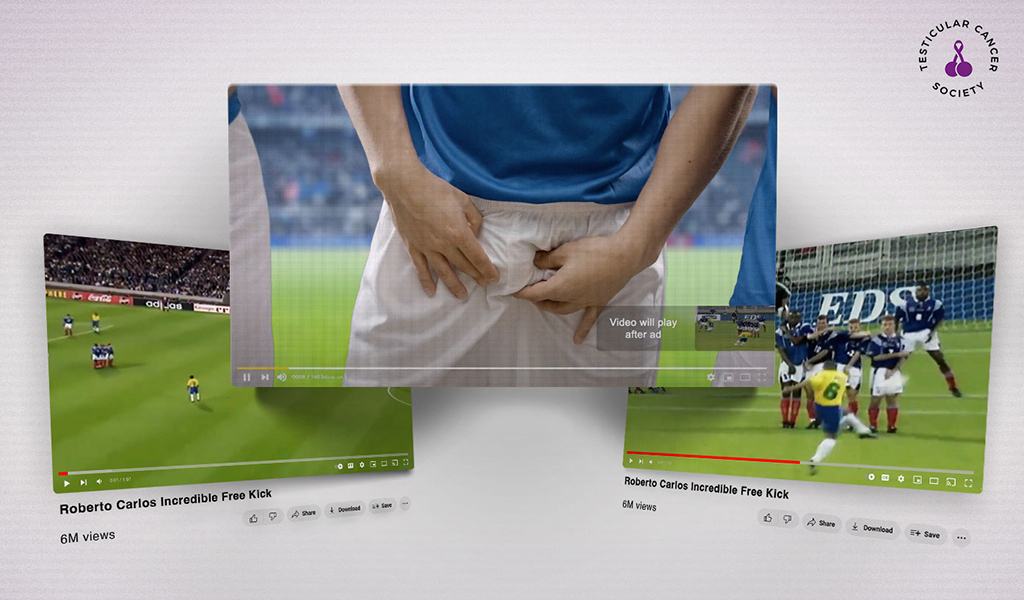Mike Craycraft, founder of the Testicular Cancer Society, grew up playing soccer.
His love of the sport has a critical connection to his disease diagnosis nearly two decades ago.
“I felt a lump and after first remaining silent for seven months, I began the process of diagnosis in June 2006, which happened to be a World Cup year,” he tells MM+M. “As weird as it sounds now, looking back, my goal was just to live long enough to see one more World Cup final.”
When FP7 McCann Dubai came to him for a disease education campaign timed to coincide with Testicular Cancer Awareness Month in April, he said he got chills because the concept immediately resonated with him.
The idea that FP7 McCann Dubai presented became the basis for the Highlight Your Balls campaign, which leverages YouTube’s mid-roll technology into soccer, or football if you prefer.
The effort highlights one of the most common aspects of the sport: free kicks. This is a point during the game when defenders instinctively shield their groins, protecting their testicles.
For the team at FP7 McCann Dubai, this occurrence and the topic of testicular health made too much sense to pass on it.
“We would use that moment to talk about how men can protect their testicles – not only during the game, but also during their lives,” says Paulo Engler, senior creative director at FP7 McCann Dubai. “YouTube ended up being the best media to make it work.”
The campaign uses YouTube’s mid-roll technology to ensure the content plays right before the free kick.
Each clip inserted into a highlight shows a close-up of three actors wearing shorts and jerseys in the same color as those of the defending team, focusing on the groin of the man in the middle of the wall.
The actor then performs a quick self-examination as a voiceover — in languages including English, German, Italian and Arabic — explains the procedure in the style of a commentator from that match highlights’ specific regions.
The ad closes with a call to visit the Testicular Cancer Society website for more information.
Kicking out misconceptions
Part of the campaign’s appeal is its ability to reach younger audiences and address one of the most common misconceptions about testicular cancer, Craycraft says.
Testicular cancer is a leading cause of cancer in young men, he explains, but often doesn’t have the same cache that other versions of the disease do, especially those that primarily impact men.
“When you think of cancer, you think of older individuals — dad, grandpa, that kind of thing,” he says. “You don’t think that it could happen to you.”
This cancer is one of the most common malignancies among men aged 15 to 45 years old and its incidence is increasing. However, the good news is that it is also among the easier cancers to treat when detected early.

“If you can catch it early and get by with a simple outpatient surgery, you can go on living life,” Craycraft says. “That’s the mission. We can’t prevent testicular cancer so early detection and treatment is key.”
The ads also help to highlight that when it comes to testicular cancer, early detection is not a complicated process.
Engler says the use of the mid-roll aids in the effectiveness of the campaign’s marketing. While acknowledging it’s such a short time to put out the message, showing people that conducting a self-check is not complex is an important tip to pass along.
Ultimately, the heart of the campaign’s approach is humor, something that has long interested both Craycraft and Engler as a unique and useful way to get their points across.
“We published a paper in 2023 [in the American Journal of Men’s Health] doing a critical review of the use of humor in testicular cancer awareness in particular,” Craycraft notes. “We know [humor] is effective though you have to be careful in the type of humor you use given your audience. This campaign has people watching football ads, football highlights and incorporating football humor. More importantly, it’s not just the message but the normalization of the conversations around testicular cancer.”
For an April 2024 article about Ogilvy’s Test-icles campaign, click here.







